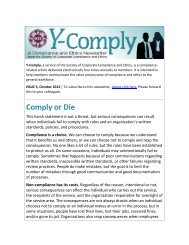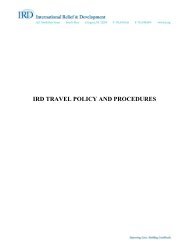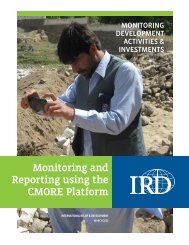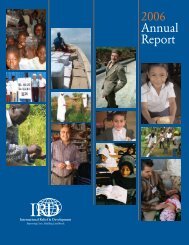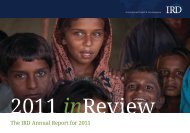Roof-Top Rainwater Harvesting Best Practices Guide - International ...
Roof-Top Rainwater Harvesting Best Practices Guide - International ...
Roof-Top Rainwater Harvesting Best Practices Guide - International ...
Create successful ePaper yourself
Turn your PDF publications into a flip-book with our unique Google optimized e-Paper software.
dissemination can sensitize the community<br />
on the potential benefits of the project’s<br />
technology.<br />
ɇɇ<br />
As part of advocacy, present a cost-benefit<br />
analysis with linkages to local institutions.<br />
This will, for example, make clear the cost of<br />
treating sicknesses due to drinking water from<br />
an unprotected water source, as opposed to<br />
the benefits of investing in clean water supply<br />
technologies.<br />
Establishing these factors in selecting a<br />
technology enables project managers to create<br />
realistic budgets, strategies for cost recovery and/<br />
or levels of subsidies. 6<br />
4.2. User Contributions<br />
Involving the communities at all stages, including<br />
financial and labour contributions is an important<br />
practice to be incorporated into project plans.<br />
Beneficiary contributions can be in the form of<br />
funds, labor, and materials, and they should be<br />
maximized, sustained, and quantified during<br />
the planning and design stages. This is an<br />
exercise to be carried out at all relevant levels:<br />
household, institutional, or wider community.<br />
Funds: A community may contribute only a<br />
fraction of the cost by way of funds, but much<br />
more in-kind, for example, by giving sand,<br />
water or bricks.<br />
Labor: Some roof-top RWH techniques involve<br />
substantial amount of unskilled labor such as<br />
earth moving and fetching of local materials. The<br />
willingness of a community to contribute labor<br />
in such a case is a substantial contribution which<br />
affects the cost of the project. It also has a positive<br />
impact on building community ownership of rooftop<br />
RWH systems.<br />
Benefits of assessing the affordability of roof-top<br />
RWH systems for the target beneficiaries, and<br />
their willingness to pay for them:<br />
ɇɇ<br />
Ability to create correct cost calculations<br />
ɇɇ<br />
The assessment will demonstrate the market<br />
opportunity for local business, and allow<br />
project to develop any private sector financing<br />
options. There is need for financial mechanisms<br />
to support the demand and income levels<br />
of interested households. The project can<br />
proceed to build local private sector capacity in<br />
roof-top RWH system manufacturing- making<br />
the systems available on the local market, at<br />
affordable prices to the local community.<br />
ɇɇ<br />
Ability to plan for building willingness of<br />
communities to cost share through, for<br />
example, advocacy and social marketing.<br />
ɇɇ<br />
Enhances a sense of (and practical) project<br />
ownership by the beneficiaries.<br />
4.3. Collaboration with<br />
Government, Local<br />
Authorities and Partners<br />
Project success will be greatly enhanced by<br />
collaborating with all relevant stakeholders<br />
in the target areas. Projects are often<br />
implemented in areas where there are preexisting<br />
or on-going projects by government,<br />
other organisations, or the community itself.<br />
Emphasis should be placed on building upon<br />
existing plans or strategies of the Government<br />
and partners to use resources more efficiently<br />
and maximize the collective impact.<br />
4.3.1. Compliance<br />
Governments will have national strategies<br />
for improving water supply and sanitation.<br />
Projects should work within these, to gain<br />
support of their project and more simply<br />
because they share the same overall goal.<br />
Key guidelines are:<br />
ɇɇ<br />
Particularly in rural areas, seek permission and<br />
involvement of authorities from the highest<br />
level down, including NGOs and all other local<br />
stakeholders, and agree on standards from the<br />
earliest stages.<br />
ɇɇ<br />
Get permission to make use of available toolkits<br />
and curriculums. Establishing a working<br />
partnership means parties will collaborate to<br />
adapt them and to incorporate missing content<br />
where it is identified.<br />
ɇ ɇ As appropriate, ensure that relevant<br />
stakeholders are informed and invited to<br />
<strong>Roof</strong>-<strong>Top</strong> <strong>Rainwater</strong> <strong>Harvesting</strong> <strong>Best</strong> <strong>Practices</strong> <strong>Guide</strong> 15



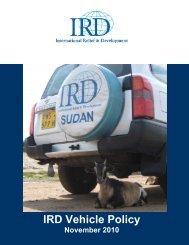
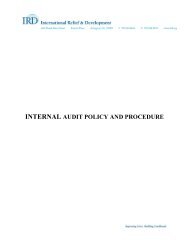
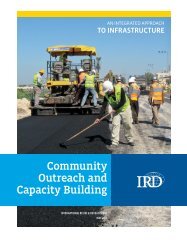
![Guide bonne pratique production d'oignon qualité_VF_4_2411012[1]](https://img.yumpu.com/23506639/1/184x260/guide-bonne-pratique-production-doignon-qualitac-vf-4-24110121.jpg?quality=85)

